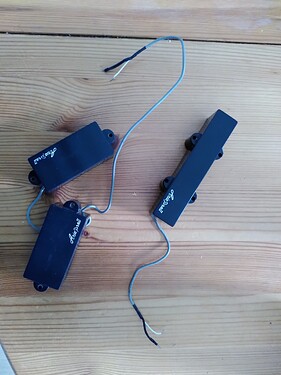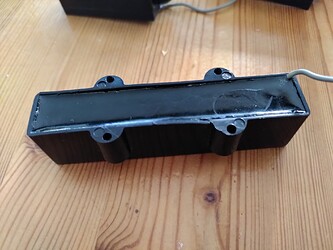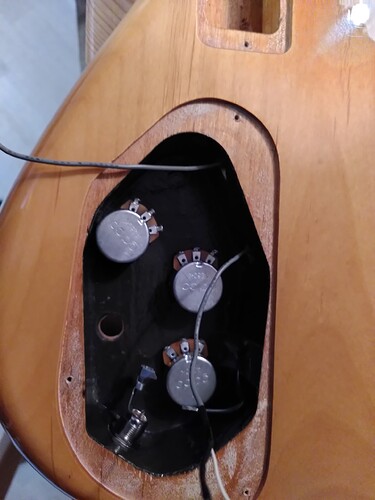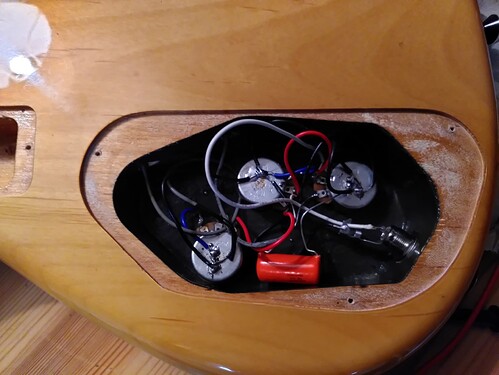Also, I was at it and measured the pickups’ resistance as well. It measures about 4.4/4.6 kOhm for both P and J. I know (from my 5-minute google search) that this is insufficient to have a complete idea of how a pickup it’s supposed to sound, but does it mean it’s unlikely to work correctly with a passive circuit? I’ve seen most P in the region of 12kOhm (DC) when the data was available and no other technical specs.
It might produce some sort of sound, but probably not very pleasant? 
It sounds like you somehow measured them in parallel? That’s about half the resistance they should have each for acceptable output.
Then again, it’s going into a preamp, so who knows. But 2-ohm pickups do not sound tenable to me.
It depends. A real P pickup with alnico magnet would normally be in the 10-12k range, but with strong ceramic magnet you can find pickups with much lower resistance. For example, Joe Barden pickups have a very low resistance (about 4k with the two coils in series) and are not weak at all. It’s also the case of some Filtertron pickups. So, the DC resistance is not sufficient : it’s more about the combination of various parameters including the coil winding and the magnets. Also the size and shape of those elements are very important, and not easy to measure …
… but yeah, that said, you should be sure that you measured the right thing. The best way is to unsolder the hot wire of the pickup and measure the resistance of the pickup alone, without any other electronic component wired to it.
I have expressed myself poorly, trying to be concise. They measure 4.4k and 4.7k (I forgot again what the P and the J are). And these values are the pickup isolated.
It also seems to me that there is no non-destructive way to open them
I don’t really understand how to be sure to replace the original pots with identical ones, and replacing them “casually” might lead to mediocre results and more costs later on.
So I’ll probably stick to the original plan, new passive pickups with an easy and understandable circuit.
I don’t mind digging and learning new stuff, but so far, I haven’t found good material. There are pieces of info here and there over the internet to stitch together, a book (how old school!) might offer a more structured overview… maybe for future projects ![]()
I’d go ask on talkbass. Someone will know.
Use your multimeter to measure resistance across the pot when fully turned - then match resistance with new (make sure you’re on the right leads for the direction the pot is turned.
Yeah, that’s fine, that’s most probably what I said : big ceramic magnets and low coil winding. nothing wrong with this.
Well a pot is quite easy to measure. A pot is built like this :
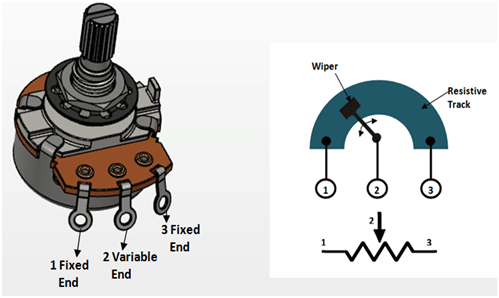
When the pot is alone and disconnected, you have to measure :
- measure the resistance between the two fixed end (1 and 3 pins), it will give you the resistance of the pot
- then, set the pot in the middle position and measure between 1 and 2 , and 2 and 3. If your measures show approximaticaly half the value of the resistance you measured before between 1 and 3, then your pot is a LIN = B taper. if the values are greatly different, which means that your pot is asymetrical, then it’s a LOG = A taper. (it can be a REVERSE LOG = C taper but those pots are quite rare)
Also often the values are writen directly somewhere on the pot itself. But as you can see, it’s easy to measure which pot you have.
Thanks for the explanation.
I did try to measure the pots precisely as you describe, but I didn’t get any meaningful value (I guess it’s “infinite resistance” due to internal defects?) for most of the positions, except for a very small range for each pot. And that’s usually very close to one end at about 0 resistance, so not really useful 
But now I know that I would need three linear 100k and one logarithmic 100k pot to exactly replace the existing ones (the marks are still barely legible) 
Any chance you know what 2LW on the A100k pot also means? is it anything important?
I think, I still prefer going the passive route. But there is time until Santa brings new pickups, so there is time to assess the situation a bit longer…
edit: ah, wait, the key here is to disconnect the pots first, which I have missed. Would be useful to double-check and also verify which ones need replacement (volume for sure, the others not so much).
I don’t remember if those pots you have were on a passive or active electronics. If the bass was passive already, then you’ll be good with new A100k and B100k pots.
Otherwise you’d want to replace them with A250k and B250k new pots for passive operation.
I don’t know what 2LW means, probably nothing very relevant.
It’s battery-powered, so something in the circuit must be active ![]()
Do you think it’s possible to “recycle” the pickups in a passive-style circuit? Well, I could buy the new pots (250k) and already set up the electronics for passive operation. If it sounds shitty, new pickups for Christmas, and that’s it…
Thanks
The good thing with 2 volumes, you can blend the sound of your 2 pickups.
Most probably. The pickups themselves are passive, so they should work in a passive circuit. The only risk is a weak output, but it’s worth a try in my opinion.
exactly ![]()
So, let’s give this plan a try…
Annuntio vobis gaudium magnum: habemus PJ

(still some work to do, but actually it does not sound bad…)
That is a great looking bass @paolo.pfm, looks worth it to bring it back to life.
